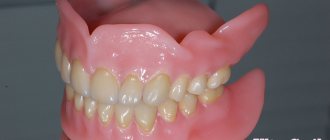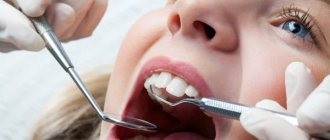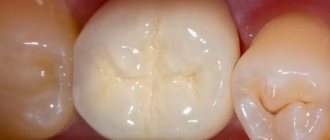The longevity of using veneers on teeth depends on two main factors: 1) the quality of installation and the material from which the veneer itself is made, and 2) the correctness of subsequent care for it by the patient.
If the first point can be achieved by choosing well-established specialists, for example, our Moscow dental clinic “VivaDent”, then the second factor is entirely within the competence of the patient and depends on his consciousness and conscientious implementation of the necessary actions to maintain oral hygiene at the proper level.
Immediately after the veneers have been successfully installed, it is necessary to provide them with proper care, not forgetting the importance of regular visits to the dentist. Only the combination of these two measures will guarantee a long and trouble-free service life of this type of prosthesis.
In the case when we are talking about ceramics as the material from which the veneer was made, then with proper handling and compliance with all recommendations, its service life is practically unlimited and is not inferior to the same parameter as your real teeth.
At the same time, ceramic veneers have the undeniable advantage over natural teeth that they are not at risk of caries. However, if you do not follow the necessary care regimen for teeth on which veneers are installed, then there is a risk of carious processes forming in the uncovered areas of the tooth.
The surface of the veneers is specially made so smooth that plaque is not able to form on it, and for this reason, hygienic care for veneers is much simpler and less demanding than for natural teeth.
However, do not be mistaken in thinking that veneers form a single whole with the tooth and are able to withstand loads similar to the latter.
What you can and cannot eat after installation of veneers and lumineers
If you have veneers and lumineers, the most important thing is to limit the load on the front teeth. That is, give up anything solid—excessive pressure can cause the plates to crack or peel off.
- do not bite off any food, even the softest. You need to get used to cutting or separating foods into small pieces - this applies to vegetables, fruits, meat, crackers and even cookies. Chew only with lateral teeth without overlays,
- give up the seeds - at least peel them by hand and chew them with your side teeth,
- use fibrous foods with caution - they can get stuck in the interdental spaces - it will be quite difficult to remove them with dental floss,
- it is necessary to abandon “coloring” foods (beets, red wine, black tea, coffee) or minimize their consumption, since the risk of changing the shade of dentures, especially composite and ceramic ones, significantly increases,
- Sudden changes in temperature (first eating hot meat, then drinking it with cold milk) are prohibited, as are too hot or cold foods and drinks - this can lead to cracks in the material and resorption of the composite glue. Ultimately, the overlay will simply come off.
There is absolutely no difference between veneers and lumineers in terms of care. They are fixed equally well, but veneers may fit the gum a little less tightly - the thicker the plate, the more “step” remains between the veneer and the mucous membrane. It can chafe and cause inflammation. Therefore, it is the gums that need to be given the most attention after restoration.
Reasons for darkening of the linings
In some cases, after aesthetic restoration of teeth with veneers, patients notice their darkening after some time. Such products are made of ceramics and composite, the latter of which tends to change the original shade during use.
In such a situation, a complete replacement of the microprosthesis is required, since bleaching procedures for such material are ineffective.
Ceramics does not tend to darken over time, but in exceptional cases this material also changes color.
This problem occurs in the following cases:
- The adhesive base has broken .
Ceramic bases are resistant to the effects of pigments, however, they do not have complete protection against changes in shade. Due to the destruction of the fixing substance between the tooth and the veneer, particles of coloring food form a bacterial plaque, which changes the color of the enamel of natural units. A thin overlay is not able to hide this defect, because... completely imitates the structure of the surface layer due to its light transmittance. - Excessive care of the pads. Most patients take special care of installed products, wanting to extend their service life in this way.
For this purpose, they use bleaching agents with a chemical and highly abrasive composition, hard toothbrushes and other devices with an aggressive effect.Such care causes the formation of microcracks, abrasions and other damage on the surface of the linings, which facilitate the penetration of coloring substances into the structure of the product.
Remarkable! It is not always possible to remove the overlay without deforming it, so more often than not, when a darkening problem occurs, a specialist installs a new structure.
What hygiene products should you have in your arsenal?
Hygiene products after installation of veneers and lumineers
| Name | Description |
| Toothbrush | Only with soft bristles - use it to clean the very surface of veneers and lumineers. Too hard hairs can lead to cracks. The teeth themselves can be brushed with a regular, medium-hard brush. Do not use electric brushes specifically for teeth with veneers - vibration can lead to the veneers coming off. Again, such brushes use quite aggressive bristles and even plastic elements that can damage the material and make it rougher - you should definitely avoid such attachments. |
| Toothpaste | Without the addition of abrasive particles (not bleaching!), such a paste can also lead to the formation of microcracks on the surface of the dentures. |
| Irrigator | Allows you to clean both the interdental spaces and the surface of the veneers from plaque. An additional bonus is a massage of the gums - the mucous membranes are saturated with oxygen, metabolic processes in them are restored. |
| Mouthwash | Choose the product that you need, taking into account your existing problems: to combat gum inflammation, to reduce tooth sensitivity, to strengthen enamel (with fluoride). |
When to use
The list of indications for the installation of composite veneers includes:
- irregularities present on the front units;
- chips;
- enamel microcracks;
- large interdental spaces;
- discoloration that cannot be bleached.
Typically, the described technology is used if you need to correct the appearance of one or two teeth. There is never any talk of large-scale work involving the use of a composite. If there are multiple defects, gluing ceramic overlays is considered a more rational way to eliminate them.
How to properly brush teeth with veneers and lumineers
There is nothing special here: in the morning before breakfast and in the evening after all meals using a brush (how to choose it - see the sign above) and paste. Complete the complex with the use of an irrigator, and finally rinse the mouth with mouthwash.
After each meal, it is mandatory to remove any leftover food. Preferably again with the help of an irrigator. It is important to maintain the condition of not only the veneers, but also the teeth underneath them, as well as the gums. Remember that even with dentures, teeth are destroyed - you can simply lose them.
Important points
Another positive effect of veneering is the improvement of gum health. This happens thanks to the perfectly adjusted contours of the veneer.
But there may be cases when the gums begin to become inflamed, ache or bleed. If you notice such manifestations, then something is wrong. Maybe there were some errors during installation, and you will need to return to your doctor for correction.
The main factors in which you should immediately consult a dentist:
- sore gums, swelling, bleeding, discomfort;
- the veneer does not fit perfectly to the tooth, mobility is felt;
- the appearance of gaps or roughness at the attachment point;
- in case of a chip of a part of the prosthesis;
- at the first manifestations of caries in the exposed part of the tooth.
After assessing the situation, the dentist can replace or correct the veneer. For example, in cases where a small part of it has broken off, you can polish the desired area without replacing it.
Can I use dental floss?
There are no clear prohibitions on the use of dental floss and interdental brushes, but you need to be extremely careful when using them. After prosthetics, microgaps between teeth are naturally preserved. But here it is very important not to move the thread from the gums to the edges (i.e., not to make vertical movements) - of course, not immediately, but gradually due to such actions the lining can be damaged. If you want to use floss, insert the tip not from below (from the cutting surface), but directly into the area between the teeth in the gum area - into the largest gap. After cleaning, remove it in the same way.
The same with brushes - when you remove them from the interdental space, be extremely careful. Choose the thinnest brushes. And best of all, buy an irrigator. This is an excellent replacement for both dental floss and brushes.
“Pay special attention to the condition of the gums, especially where the mucous membrane comes into contact with the edge of the veneer or lumineer. Due to tissue injury, inflammation may occur, which will lead to the fact that the pads will have to be removed for treatment, or due to a violation of aesthetics. For example, if gum recession begins and the roots of the teeth become exposed.”
Dzhutova Aida Vladimirovna Implant surgeon, periodontist Experience more than 10 years make an appointment
Do you dream of a beautiful smile? We have developed COMPLEXES of veneers for the smile area - place 4, 6 or 12 onlays at once! Save up to 30 thousand rubles and get a Hollywood smile!
sign up now
Content:
- When to use
- Contraindications for installation
- Installation process
- Techniques for performing composite restorations
- How long do they serve?
- Features of care
- Advantages and disadvantages of direct veneering
Veneers made from composite material are overlays that are used to provide an aesthetically pleasing appearance to the smile area.
This type of microprosthesis allows you to make the incisors and fangs lighter and more beautiful, give them the correct shape, and change the cutting edge of the coronal part. Direct composite restorations should not be confused with ceramic ones. The latter are the thinnest plates made in a dental laboratory. Their cost is always higher.
When they talk about using a composite, they mean a mixture from which an element of the required shape is formed right in the client’s mouth. The dentist applies the prepared composition layer by layer, and then polishes the unit to make it perfect.
Is it possible to carry out professional hygiene with veneers and lumineers?
Not only is it possible, but it is also necessary. When performing hygiene, be sure to remind the doctor that you have dental veneers installed in order to select a gentle ultrasonic treatment mode. Frequency – 1-2 times a year or as needed, depending on the quality of home care. But many patients, after installing veneers, carry out hygiene without effort, i.e. They treat renewed teeth with care, which causes plaque to accumulate faster. So you need to be prepared for the fact that you will have to undergo comprehensive cleaning even more often.
Air Flow technology is prohibited because abrasive particles are used - they can damage the smooth surface of the pads. Remember about home hygiene - this is the only way to maintain the health of your teeth and the condition of your microprostheses.
Main indications for use
Composite veneers are placed for different purposes. There are many indications for their use. Here are the most common reasons for installing veneers:
- incorrect position of teeth;
- stains on enamel that cannot be removed by bleaching or professional cleaning;
- cracks and chips;
- enamel erosion;
- diastema;
- unsightly fillings on the cervical area of the crown;
- certain malocclusions;
- minor irregularities;
- loss of a large part of the tooth.
In some situations, the doctor may refuse the patient or delay the procedure. The following contraindications for the installation of composite veneers are identified:
- malocclusions that can be corrected with braces;
- bruxism;
- damaged or naturally too thin enamel;
- bad habits (smoking, opening bottles with teeth, biting nails);
- employment in heavy production or passion for extreme sports;
- small crown, too crooked surface, too short teeth;
- poor dental hygiene, failure to take proper care of the oral cavity;
- diseases in the acute stage, inflammatory processes, carious cavities, viruses, infections and other problems that need to be eliminated;
- absence of nerve;
- mobile teeth.
Is it possible to smoke if you have veneers?
Of course, you need to give up smoking. Firstly, for the general health of the body. Secondly, in order to preserve the color of the veneers. Of course, they will darken along with the enamel of living teeth, so there will be no obvious contrast. But unlike natural teeth, they cannot be whitened – the process is irreversible. Thirdly, when smoking, the gums suffer greatly - with veneers, the risk of mucosal recession increases, and when smoking it is even higher. Therefore, if possible, it is still better to give up this bad habit. Or at least strengthen hygiene and visit a doctor for comprehensive cleaning 2-3 times more often.
How do you know when it’s time to change veneers?
Monitor the condition of the veneers, the quality of their fixation on the teeth, pay attention to microcracks, gaps and roughness - even in a small gap between the veneer and the enamel, bacteria will accumulate, which will lead to the destruction of living tooth tissue. Do not forget that in order to maintain the warranty on the product, you need to visit the dentist every six months - he will be able to assess the condition of the veneers and the teeth under them. He will also clarify that it is time to update the prostheses. However, this may be required after at least a couple of years if you do not take care of hygiene, and at least after 10 years (depending on the material) if you take care of your new teeth.
Choosing between veneers and lumineers? Only original Cerinate and DUO lumineers. No fakes, 100% quality guarantee.
sign up now
Reviews
Proper care of veneers is not difficult. But all recommended procedures aimed at proper hygiene require patience and systematicity.
Only high-quality care and careful handling of products will help you maintain a perfect smile and attractive appearance for a long time.
If after reading the article you have a desire to talk about your personal experience of quality care for the products presented, leave your review in the comments below.
If you find an error, please select a piece of text and press Ctrl+Enter.
Tags veneers care
Did you like the article? stay tuned
Previous article
The essence of ultrasonic dental implantation and aspects of its implementation
Next article
Are canine braces the only way to correct a “vampire smile”?
Can veneers and lumineers be whitened?
No, veneers, lumineers and any filling materials (composites) cannot be whitened. The chemical properties of the gel allow it to penetrate only between the tissue cells of natural teeth. During cleaning and polishing, you can only remove plaque - then teeth with dentures will really become whiter. Therefore, it is so important to maintain hygiene and carry out daily cleaning on time.
As you can see, lifestyle and hygiene when having veneers on your teeth are quite simple, and, in fact, are not much different from the rules for caring for your own teeth. Remember: how long veneers or lumineers will last depends not only on the quality of the work done by your doctor, but also on you.
Lifetime
The duration of operation of the plate, which replaces the outer layer of teeth, depends on its strength.
Composite products are made from high quality composite filling composition. Patients prefer such products because of their affordable cost; moreover, this type of restoration can be used by any dentist.
But you shouldn’t count on long-term cosmetic effects. Such products remain on the surface of dental elements for no more than 5 years and quickly change their original shade.
Ceramic veneers have a longer service life. Due to their good resistance to staining and stress, such plates serve their owner for at least 15 years , and with good care this period can be doubled.
The effectiveness of dental restoration with plates depends on the following factors:
- material used in manufacturing;
- physiology of teeth;
- individual structural features of the dentofacial apparatus;
- food consumed by the patient;
- compliance with the recommended rules for caring for products.
The video provides additional information on the topic of the article.











